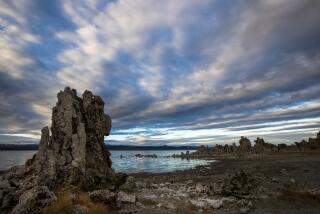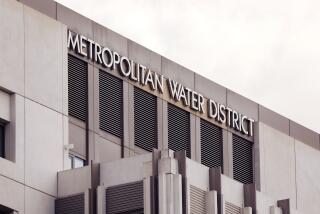City Taps Its History to Escape the Drought : Water: San Fernando is fortunate to have rights bestowed by a Spanish land grant. But it took 24 years of legal battle to get them recognized.
While many Southern California cities are struggling with drought-imposed cutbacks, San Fernando is not, thanks to a little bit of history, a little bit of geography and a lot of legal wrangling. “We could turn off MWD for a year, never cut back and still have an adequate supply,” Public Works Director Michael Drake said.
Less than a quarter of the city’s annual water supply comes from the Metropolitan Water District of Southern California. The rest--more than 3 million gallons a day--is supplied by four city-owned wells in the Sylmar Basin. In addition, San Fernando has bought surplus water from the MWD over the last three years and now has about 325 million gallons in reserve.
In dry times, San Fernando is rich.
San Fernando was deeded the rights to pump ground water in the basin in the city’s original Spanish land grant, but it took a 24-year legal battle before those rights were guaranteed in modern law. The city of Los Angeles sued San Fernando in 1955 to gain control of pumping rights in the basin. All of San Fernando’s wells are outside its city limits.
Los Angeles claimed in the suit that the water belonged to it because early Spanish law dictated that the city had all rights to ground water that feeds the Los Angeles River. But in 1979, the California Supreme Court ordered San Fernando and Los Angeles to share the water equally.
San Fernando’s 21,500 residents use about 1.4 billion gallons of water a year, Drake said. By comparison, the 3.4 million residents of Los Angeles use about 228 billion gallons, according to Los Angeles Department of Water and Power spokesman Ed Freudenburg. More than 60% of Los Angeles’ water comes from the MWD.
The MWD, which supplies as much as 3 billion gallons a day to 27 water agencies from Ventura County to the Mexican border, ordered a 17% cut in overall usage on Jan. 8 in response to California’s worsening drought. Only a handful of cities have escaped the effects. Others have said the cuts will force mandatory rationing.
Burbank, for example, depends completely on the MWD for water. Although Burbank has 10 municipal wells, no water has been pumped from them for three years because of ground-water contamination in the southeastern San Fernando Valley. Ronald V. Stassi, general manager of Burbank’s public services department, said a plan to cut water use citywide is scheduled to be presented to the City Council this week.
Drake said San Fernando has been able to avoid contamination problems like Burbank’s because there is little industry in the area around the wells. Burbank, on the other hand, is home to hundreds of small machine shops as well as to Lockheed Corp. Wells in the area are the objects of a federal Superfund cleanup.
Even with a plentiful water supply, Drake said, San Fernando officials are considering programs to cut water use by 10% to guard against further MWD cuts and a prolonged drought that could threaten the city’s ground-water supplies. Since 1986, Drake said, the city has been able to reduce water consumption by about 15% through voluntary conservation programs.
More to Read
Sign up for Essential California
The most important California stories and recommendations in your inbox every morning.
You may occasionally receive promotional content from the Los Angeles Times.









